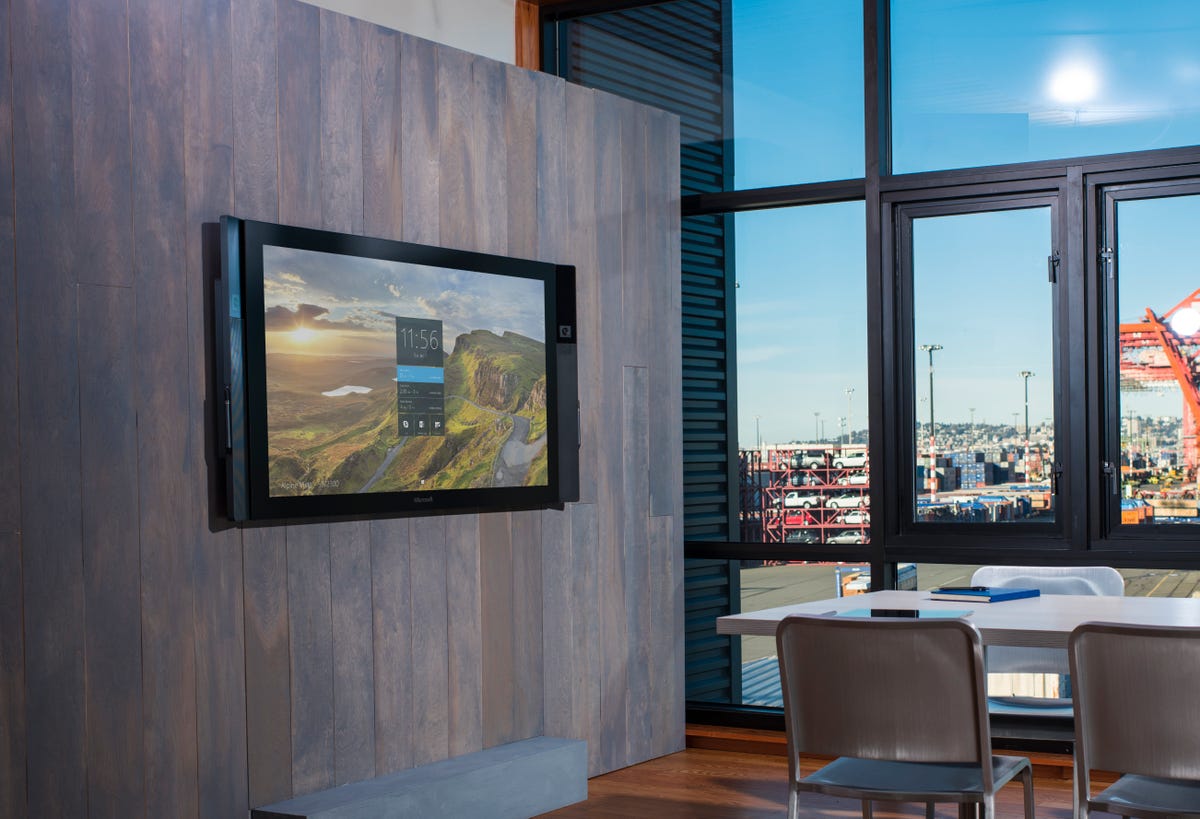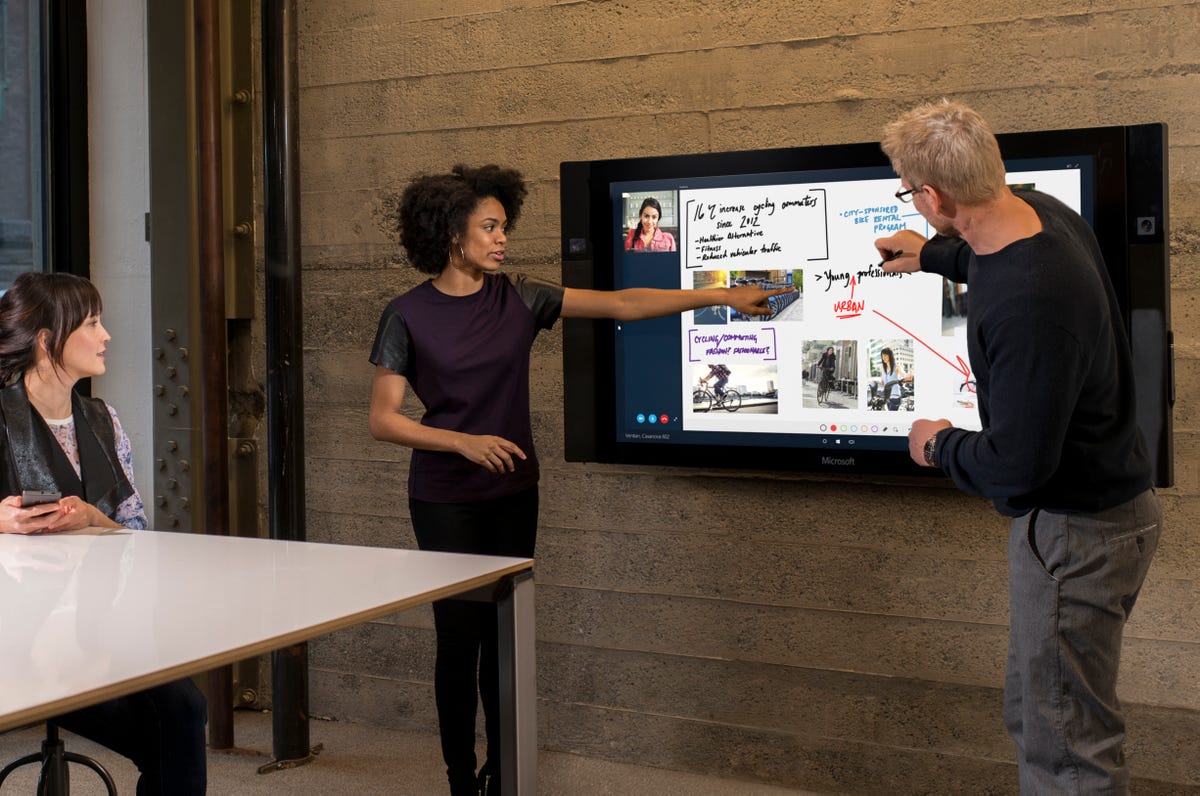
Microsoft
LAS VEGAS — Nestled between two false walls in a lavish suite at the Venetian hotel and casino is what I think is an enormous television. Here, during the chaos of the annual Consumer Electronics Show in early January, too-large TVs are par for the course.
What gives this particular display away is the word Microsoft emblazoned below the bottom bezel. When Jeff Han, a multitouch researcher who’s now a general manager at Microsoft, approaches the device he taps the screen to bring it to life.
The device is called the Surface Hub and it’s essentially a gigantic tablet running Windows 10. In fact, it’s an 84-inch “ultrahigh-definition” touchscreen display. But it’s more than that: packed on top, bottom and to the side of the screen, as well as inside the device itself, are several of Microsoft’s Kinect motion sensors.


Now playing:
Watch this:
Up close with Microsoft’s 84-inch 4K Surface Hub
1:02
The company is going to great lengths to get the Surface Hub in the spotlight. Microsoft featured the device during its “Windows 10: The Next Chapter” event at its Redmond, Wash,. campus on Wednesday. It did so stealthily, putting the device front and center with a Windows 10 logo and nothing else, choosing to unveil it later on in the presentation.
The device can notice people in the room and can pick up audio from anyone in its vicinity. It can also run any Windows app, and it can do that through Skype from any connected device, regardless of whether that tablet, laptop or desktop is running Windows 10. For instance, the Surface Hub will let even iPad users connect to it and share files, as long as the iPad is running Windows software like Word or PowerPoint.
Ultimately, Microsoft wanted to create something that could withstand an infinite number of inputs, a device for serious work. “You’re not going to use Google, Apple or Samsung,” said Mike Angiulo, the corporate vice president of Microsoft’s Devices Group. “We had to create machinery that didn’t exist.”


Microsoft
It may seem like a strange, meandering return to the original Surface, those coffee-table-like touchscreen gadgets that the company first unveiled in 2007. A few companies used it — retailers such as AT&T had a few in their stores help customers understand the differences between various products placed on its surface — but it ultimately didn’t catch on. In 2012, the company unveiled a tablet called the Surface, and renamed the table PixelSense.
Still, the company has ambitions beyond a computer, smartphone or video game console. Microsoft is one of several companies attempting to build devices for several users to interact with at once. Lenovo, for example, unveiled a 27-inch tablet computer in 2013.
To Microsoft, the Surface Hub isn’t just a way for several people to interact with a computer at once. It also replaces projectors, teleconference technology, team video chatting and scores of other activities. The Surface Pro Hub is both an attempt to get Microsoft products on the walls of every business, and a way to further push Microsoft software into the workplace, even as the company opens its arms to other companies’ devices running its applications.
The Surface Hub is the fruits of a 2-year-old acquisition of touchscreen maker Perceptive Pixel. That brought Han, the startup’s founder, to lead the project. Before that, Perceptive Pixel sold $80,000 touchscreens to TV media organizations like CNN and Fox News, which rely on those types of mammoth devices for election coverage and other events.
But who else needs, or let alone wants, an 84-inch touchscreen? Microsoft’s answer — and its hope — is any company or team that uses a conference room at all.


CNET
Microsoft won’t say what the device will cost. Perceptive Pixel’s $80,000 devices eventually plummeted in price, down to $7,500 for a 55-inch version. Microsoft plans on offering a 55-inch Surface Hub as well as an 84-inch version. Still, at $15,000 to $20,000 for the flagship model, the displays are not casual purchases and won’t be finding their way to small businesses any time soon.
More important than cost, however, is whether other companies will buy into Microsoft’s vision for multi-touch, multi-person productivity.
Teleconference systems cost upwards of six figures, and many large corporations use legacy software and industry standard equipment to conduct audio and video meetings with employees around the globe. Companies such as Cisco and Polycom have worked for years to build “telepresence rooms” with multiple HD displays and well-placed audio microphones.
The Surface Hub wants to accomplish with one gadget what many devices accomplish in tandem.
“There are no cables dangling, no projectors, no phones,” says Angiulo. Because the device is running on the same base of code as other Windows 10 machines, developers will be able to customize productivity apps for the 55-inch and 84-inch screens and take into account how the software can be shared among dozens of participants.
In my time using the device, the Surface Hub proved unlike any other gadget I’ve ever used before. The touch interface is as responsive as any smartphone, and writing and operating with multiple hands is flawless. Intuitively, I was able to pull up Bing Maps, zoom out to space and spin a virtual Earth to find the location of the CNET offices in downtown San Francisco.
Jokingly, I wondered how long before we’ll be playing the popular military shooter Call of Duty on the 84-inch 4K monitor. Han says the Surface Hub has been used any way imaginable inside Microsoft’s offices, including hooking up an Xbox One game console to it.
Yet it’s still unclear how the Surface Hub will be used to enhance the productivity of large groups of people beyond Microsoft’s whiteboard brainstorming and Skype video conferencing examples. With a presumably high price point, little evidence of how companies will use it and questions about how developers will treat it as part of the Windows ecosystem, the device still feels like a gimmick waiting for a cause.
But Microsoft’s intention is to convince businesses that thinking, communicating and collaborating in the workplace will in fact improve with the presence of these colossal screens, even if they marvel only with hardware for the time being.
“Our intention,” Han says, “is to make this ubiquitous.”




